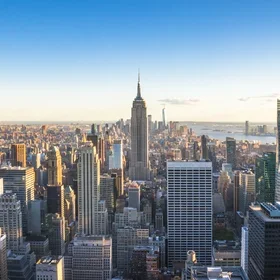By Dr. Steven Cohen, Senior Vice Dean, School of Professional Studies; Professor in the Practice of Public Affairs, School of International and Public Affairs
New York City has an amazing collection of over 550 community gardens that are located in all five boroughs and are supported by the Parks Department’s GreenThumb program. According to the Parks Department’s website:
“Established in 1978, GreenThumb is proud to be the nation’s largest urban gardening program, sustaining over 550 community gardens and supporting thousands of volunteer gardeners throughout New York City. GreenThumb gardens create hubs of neighborhood pride and provide a myriad of environmental, economic and social benefits to the neighborhoods in which they thrive. GreenThumb’s mission is to support and educate community gardens and urban farming across the five boroughs, while preserving open space. By providing free garden materials, technical assistance, educational workshops, and seasonal programs, GreenThumb supports neighborhood volunteers who steward community gardens as active resources that strengthen communities.”
During the 1960s and 1970s, about 10,000 vacant lots were transferred from private to public ownership, largely due to the failure of landowners to pay real estate taxes. We saw a similar phenomenon with abandoned buildings. I know it’s hard to believe, but there was a time when people were abandoning the city, and buildings and land in some parts of town had little value. In some cases, local folks just took over vacant lots and converted them into gardens. There has been a long-term battle between garden and housing advocates about the best use of vacant land. Some housing advocates are seeking to address housing affordability, while others are developers trying to make money. Earlier this year, Gothamist published a terrific three-part series on community gardens. In one of these pieces, Arun Venugopal, writing about these spaces, observed that:
“They’re public places where private citizens have to jointly decide the best use of a precious resource. This tradition of collectivism goes back to at least the 1970s, when some New York City neighborhoods were pocked with vacant lots that were typically the result of urban neglect. But as many community gardens became the green oases and urban jewels they are today, they had to overcome significant political hurdles and existential threats, including vehement opposition from former Mayor Rudy Giuliani.”
The disgraced former “America’s Mayor” wanted to monetize these spaces and was no fan of community-based organizations. In addition to the 550 community gardens, there are also over 700 school gardens, 700 gardens on New York City Housing Authority (NYCHA) land, and about 100 gardens in land trusts. These green spaces are valuable because they all provide ecological services such as combating the heat island effect, providing drainage during rainstorms, and directly absorbing carbon dioxide. The community gardens are also social and educational resources.
Around the corner from my apartment, there is a community garden called the Gatehouse Garden. When I walk to work, I often see a couple of chickens along with school children, teachers, and neighbors working in the garden. In a wonderful Columbia Spector piece last spring, Isabella Noonen observed that:
“The Gatehouse Garden on the corner of 119th Street and Amsterdam Avenue sticks out amid the apartments and campus buildings that surround it—a vibrant community space and green oasis. The garden’s plant beds and red brick paths wind around its namesake: the 19th century Old Croton Aqueduct gatehouse sitting at the center of the lot. A squat granite building covered in foliage, it more resembles a quaint country cottage or medieval fortress than a part of modern Morningside Heights. Now surrounded by plants and chickens, this unassuming structure was once part of New York City’s first water system, a 41-mile-long aqueduct bringing clean water from upstate to New York City.”
In nearly every neighborhood in New York City, you will see community gardens tended to by local gardeners, and these essential spaces are a critical element of the social and environmental fabric of the city.
New York City’s community gardens are also part of a network that helps compost the city’s food waste. These compost programs are suffering either benign or active neglect by New York’s city and state governments. The Mayor has cut community composting programs from his most recent budget. The Governor recently vetoed a bill unanimously passed by the state legislature to protect the state’s community gardens. Despite these negative headwinds, GrowNYC, one of the organizations running the community composting program (as well as the city’s Greenmarkets), was recently saved by a large anonymous donation. According to a post by Roshan Abraham on the website Vice:
“A New York City group operating community composting drop-offs has been temporarily saved from Mayor Eric Adams’ budget cuts thanks to an anonymous, wealthy donor, one of the nonprofits running the program announced on Wednesday. GrowNYC runs 52 food scrap drop-offs across the five boroughs. The city contracts with nonprofits and three community gardens to operate the drop-offs. GrowNYC said all the contracted organizations together account for 8.3 million pounds of organic waste that is saved from going to landfills, helping to produce hundreds of thousands of pounds of compost that is donated or sold to community groups, including farmers.”
As I noted in an earlier post, if these 8.3 million pounds of organic waste are not composted, the city must pay to transport and dump that waste in a landfill or incinerator. The budget “savings” of cutting composting may well be an illusion.
I remain baffled by the hostility to composting and community gardens—two broadly supported community-based environmental programs. The volunteerism that powers these gardens and community food waste pick-ups should be encouraged and extended to other elements of the city’s service delivery programs. In a political system powered by wealthy donors, it is not surprising that these grassroots efforts are ignored or even opposed. While voluntary food waste pick-ups will eventually be replaced by mandatory pick-ups by the Sanitation Department, the nonprofits that now collect food waste can be re-purposed by the city to perform other vital environmental services now neglected by the city. Park clean-up and clearing blocked water drains are two obvious examples, and I’m confident there are many others.
The pressure on community gardens will continue as land scarcity grows in New York City and the monetary value of these spaces increases. As in many volunteer-based efforts, they are dependent on energetic leadership and private fundraising. The Parks Department assists these gardens, but in a department as woefully underfunded as NYC Parks, the sixteen people staffing this city-wide effort have their hands full. Most of the community engagement staff in Green Thumb are responsible for over five community board districts, and all the NYCHA gardens are staffed by a single coordinator. Perhaps the Mayor could spare one of his special assistants for this important work.
The media image of New York City is concrete, glass, and pavement, even though most of the land in the five boroughs sits beneath single-family homes. Despite that fact, about 70% of New Yorkers live in apartments. For those of us living in multifamily housing, the parks and community gardens are our backyards. Community gardens are also social gathering places, a way to cut through the anonymity of urban life where we can learn about and engage with our neighbors. The contribution of these spaces to our quality of life is difficult to measure but very important. The volunteers who work in community gardens are role models for young people and are the quiet heroes that make the city work. Contrary to the image of New Yorkers as cold-hearted and self-centered, community garden volunteers are like the many people who help carry baby strollers up subway steps, carry groceries for the elderly, or perform the million acts of daily kindness that are the beating heart of our city. They deserve praise and public support.
Views and opinions expressed here are those of the authors, and do not necessarily reflect the official position of Columbia School of Professional Studies or Columbia University.
About the Program
The Columbia University M.S. in Sustainability Management program offered by the School of Professional Studies in partnership with the Climate School provides students cutting-edge policy and management tools they can use to help public and private organizations and governments address environmental impacts and risks, pollution control, and remediation to achieve sustainability. The program is customized for working professionals and is offered as both a full- and part-time course of study.



